Ageing and sexing details:
|
JAN - JUL: after-second-year
male |
ASY
males are very boldly marked birds, with a black auricular, chin and throat. The flanks are white with bold, black streaking.
Although there is a contrast between the black greater coverts and the somewhat paler block of primary coverts, primaries, and secondaries, this is less pronounced on ASY Black-and-white Warblers.
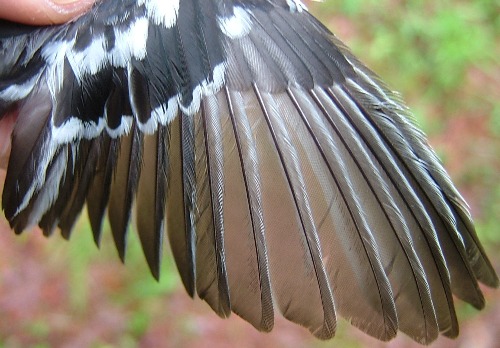
Photo by Peter Pyle, Howell Woods (NC), May 2006
The
outer rectrices
are dark, broad, and
truncate with moderate amounts of white.
RETURN TO AGE/SEX
OVERVIEW
|
JAN - JUL: after-second-year
female |
Females are easily distinguished from males in spring by having a white throat and grayish-white auriculum, as well as less distinct streaking on the underparts. Age of ASY females usually can be determined only through careful examination of the wing and tail.
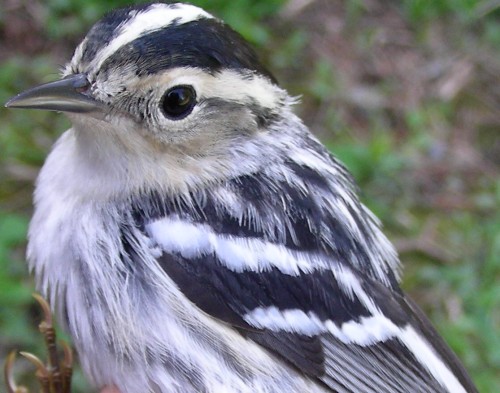
Photo by Marie-Anne Hudson,
McGill Bird Observatory (QC), May 2008
Like ASY males, ASY females show a distinct contrast between the black greater coverts and the block of paler primary coverts, primaries, and secondaries, but note that these feathers are still fairly dark and in good condition, whereas on SY individuals they tend to be more faded and worn.
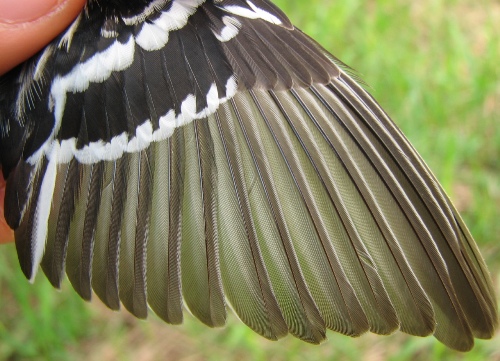
Photo by Barbara Frei,
McGill Bird Observatory (QC), May 2008
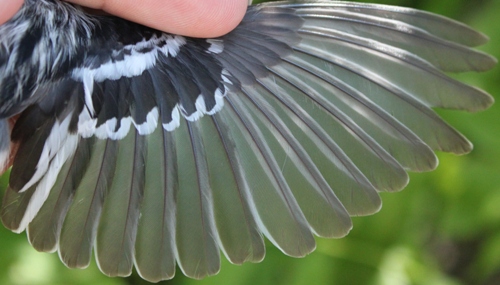
Photo by Peter Pyle, Braddock Bay Bird Observatory (NY), May 2010
ASY females have relatively broad and rounded outer rectrices, with white patches generally limited to the outermost 1-2 rectrices.
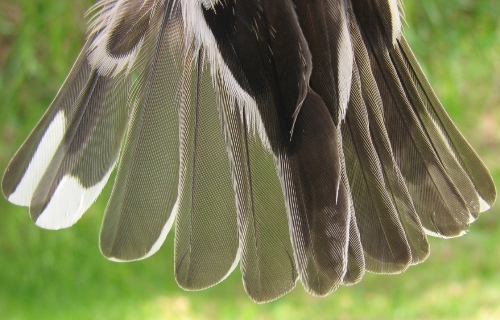
An example showing distinctly broad and rounded rectrices across the tail.
Photo by Barbara Frei,
McGill Bird Observatory (QC), May 2008
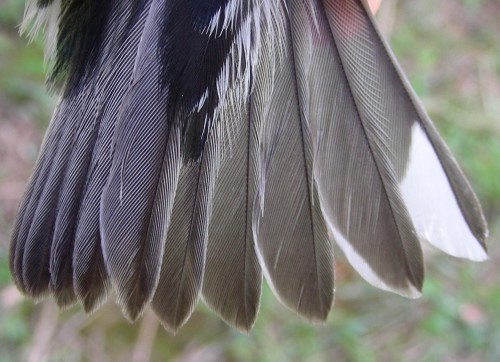
A somewhat more intermediate shape to the outer rectrices, to be interpreted with caution.
Photo by Marie-Anne Hudson,
McGill Bird Observatory (QC), May 2008
RETURN TO AGE/SEX
OVERVIEW
|
JAN - JUL: second-year
male |
SY
males differ from ASY males by having a throat usually streaked with black (rather than solidly black), and by retaining brownish juvenile feathers, which may be visible on the wings of a perched bird.
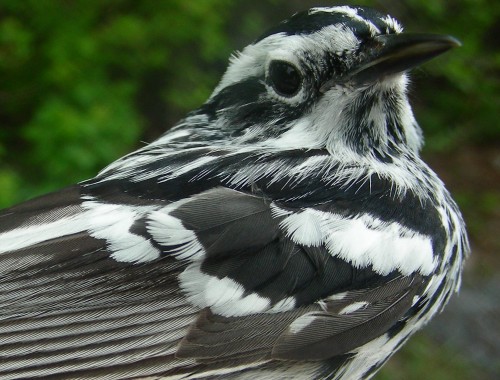
This individual shows a distinctly streaked throat, but the contrast between juvenile and
formative feathers on the wing is relatively subtle from this view.
Photo by Marie-Anne Hudson,
McGill Bird Observatory (QC), May 2007
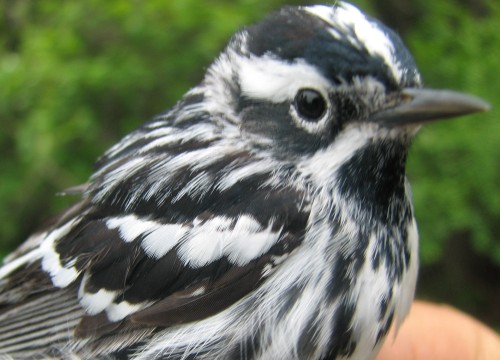
In this case, the throat is closer to the solid black typical of ASY males, but more of a
contrast between brown and black feathers is apparent on the wing.
Photo by Marcel Gahbauer, McGill Bird Observatory (QC), May 2006
SY Black-and-white Warblers show a similar pattern to ASY individuals, in that the greater coverts contrast visibly with the block of primary coverts, primaries, and secondaries. However, in SY birds the greater coverts tend to be blackish (rather than black), and the contrasting block is distinctly paler, duller, and often brownish.
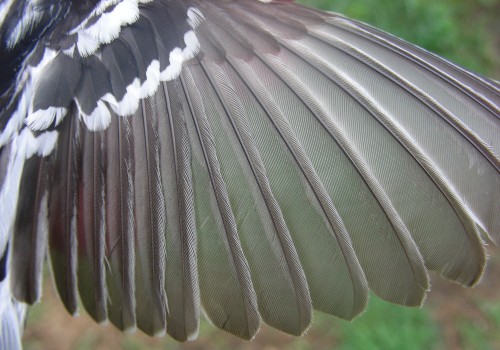
Photo by Marie-Anne Hudson,
McGill Bird Observatory (QC), May 2007
The outer rectrices of SY Black-and-white Warblrs tend to be narrower and more pointed than those of ASY individuals. The white marks are typically found on the two outermost rectrices for SY males (occasionally only on the one outermost).
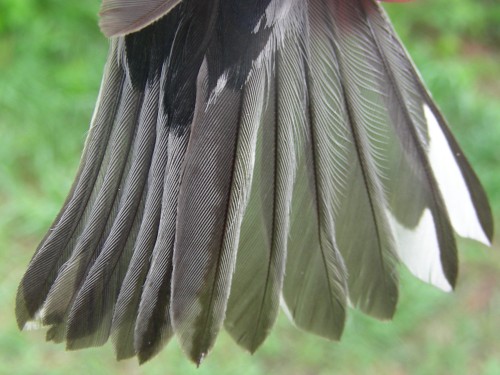
Photo by Marie-Anne Hudson,
McGill Bird Observatory (QC), May 2007
RETURN TO AGE/SEX
OVERVIEW
|
JAN - JUL: second-year
female |
Like ASY females, SY females have a whitish chin and whitish-gray auriculars; they may also have a slight pinkish-buff tinge to the cheeks, as well as the flanks, which are only very lightly streaked.

A typical SY female, pale below, and with a hint of buff on the cheek.
Photo by Marcel Gahbauer,
McGill Bird Observatory (QC), May 2010
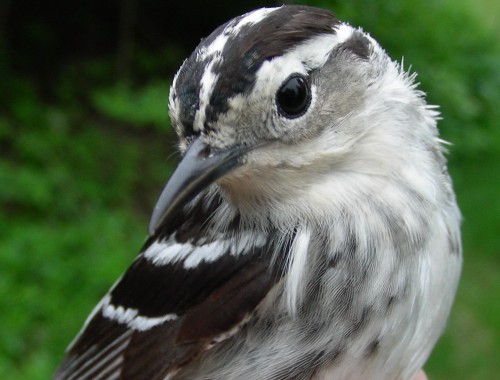
Another SY female, without any buff tones, but again with very pale underparts
showing only faint and indistinct streaking.
Photo by Marie-Anne Hudson,
McGill Bird Observatory (QC), May 2008
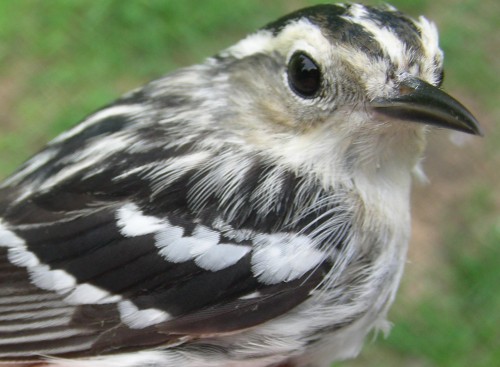
An especially pale SY female, with even the dark parts of the crown appearing
more gray than black.
Photo by Marie-Anne Hudson,
McGill Bird Observatory (QC), May 2007
As with all other age/sex classes, there is a contrast between the dark greater coverts and the paler block of primary coverts, primaries, and secondaries. Like males, the SY females show a greater contrast between these feather tracts than is typical of ASY females, with the retained block of juvenile feathers on SY females tending to be paler, browner, and sometimes noticeably more worn.
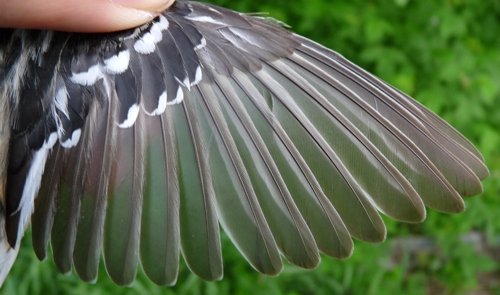
A typical SY wing, with a stark contrast in colour and feather quality between the
greater coverts and the adjacent secondaries.
Photo by Marcel Gahbauer,
McGill Bird Observatory (QC), May 2010
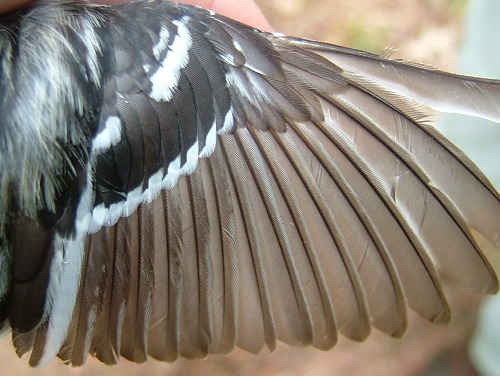
Another example, in which the greater coverts are somewhat paler than in the previous
photo; notice the distinctly pale and somewhat worn quality of the primaries and
secondaries.
Photo by Peter Pyle,
Howell Woods (NC), May 2008
As with SY males, SY females have outer rectrices that are relatively narrow and pointed compared to those of ASY Black-and-white Warblers. There is considerable overlap between SY males and females in the appearance of the tail, but since sex is readily determined by overall plumage, this is not a problem. SY females may have distinct patches only on the outermost rectrices, but often also have a patch of white on r5..
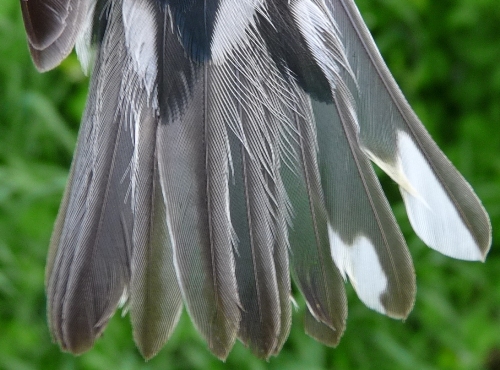
A somewhat intermediate tail with respect to shape; age would need to be determined
by the condition of the wing instead.
Photo by Marcel Gahbauer,
McGill Bird Observatory (QC), May 2010
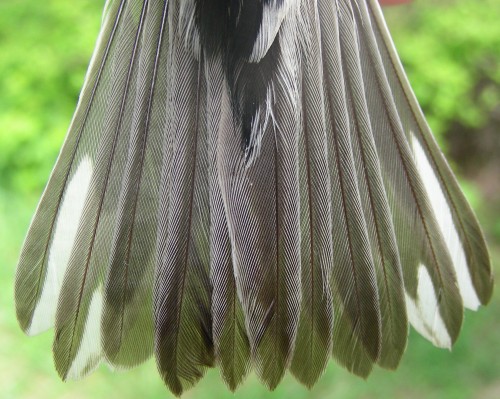
A more typical SY tail with respect to the shape of the outer rectrices; note the contrast
between the narrow and relatively pointed juvenile feathers and the lone formative
rectrix (r4 on the left side) that has been adventitiously replaced and is distinctly
broader and more rounded at the tip.
Photo by Marie-Anne Hudson,
McGill Bird Observatory (QC), May 2007
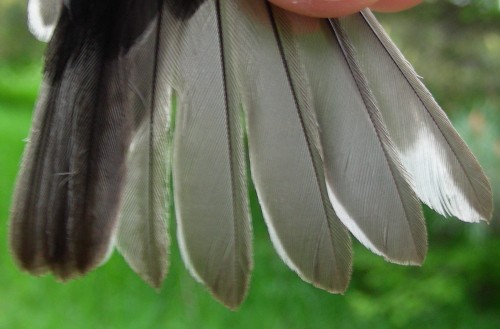
An example of a female with more limited white on the outer rectrices.
Photo by Marie-Anne Hudson,
McGill Bird Observatory (QC), May 2008
RETURN TO AGE/SEX
OVERVIEW
|
JUL - DEC: after-hatch-year
male |
AHY males are generally the easiest age/sex class to recognize, as only they have a blackish auricular and some black streaking in the throat.
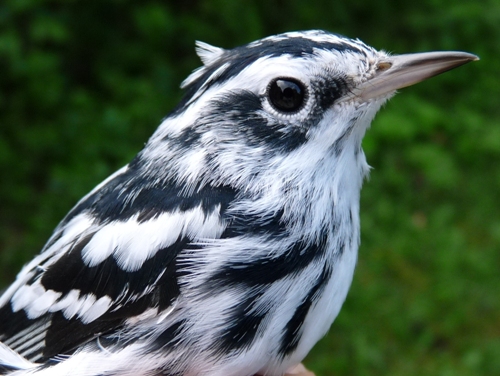
A typical AHY male, with a blackish auricular, some black streaks in the throat, and
no hint of any plumage that is not either black or white.
Photo by Marcel Gahbauer,
McGill Bird Observatory (QC), August 2009
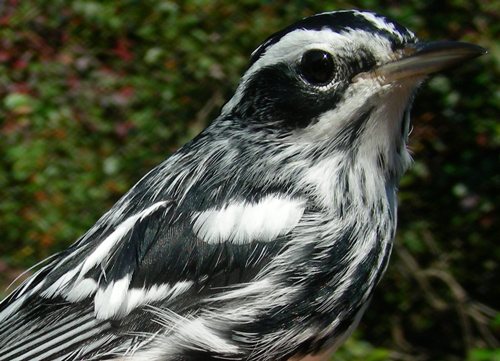
A somewhat darker AHY male, with a solid black auricular, and heavier streaking
across the underparts.
Photo by Marcel Gahbauer,
McGill Bird Observatory (QC), August 2008
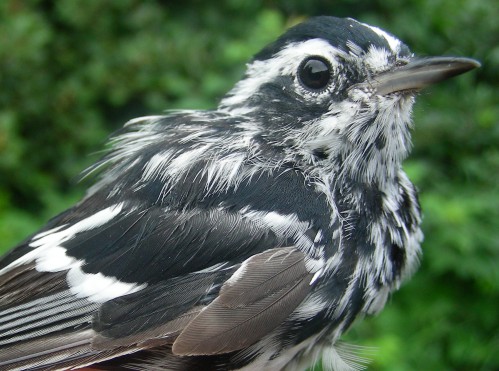
An AHY male undergoing prebasic molt; the stark contrast between the unreplaced
alula and primary coverts versus the greater coverts strongly suggests that these are
juvenile feathers, and the individual is therefore SY.
Photo by Marie-Anne Hudson, McGill Bird Observatory (QC), August 2007
AHY males have the darkest wings, though even on them there is a slight pseudolimit between the black greater coverts and the blackish primary coverts.
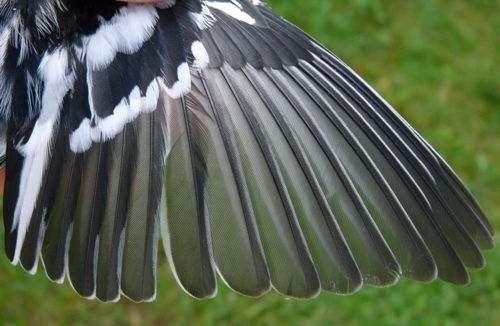
A typical AHY male, dark (blackish to black) across the entire wing.
Photo by Marcel Gahbauer,
McGill Bird Observatory (QC), August 2009
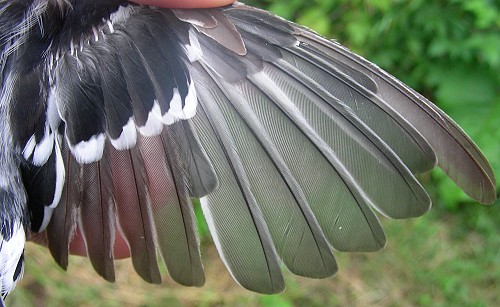
An AHY male during its prebasic molt; the particularly strong contrast between the new
basic feathers and the retained alula and outer primaries suggests that they are likely
retained juvenile feathers, and that this individual is SY.
Photo by Marie-Anne
Hudson, McGill Bird Observatory (QC), August 2007
AHY males have dark outer rectrices that are quite broad and rounded; there is usually an extensive amount of white on the outermost two rectrices, and sometimes also some on r4.
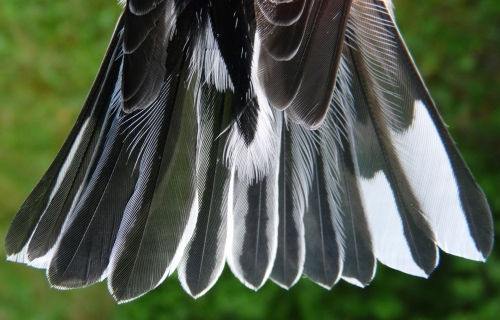
A typical AHY male tail.
Photo by Marcel Gahbauer,
McGill Bird Observatory (QC), August 2009
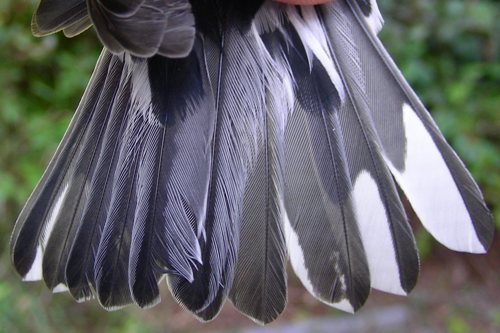
A somewhat paler tail overall, but with a bit more white extending over to r4.
Photo by Marcel Gahbauer,
McGill Bird Observatory (QC), August 2008
RETURN TO AGE/SEX
OVERVIEW
|
JUL - DEC: after-hatch-year
female |
AHY females are similar to HY Black-and-white Warblers of both sexes in that they have a pale auricular and unmarked throat. They are best separated by looking at the wing and tail, or by confirming complete skull pneumatization. Some AHY females also have a buff tone to some of their white plumage, especially on the throat and flanks.
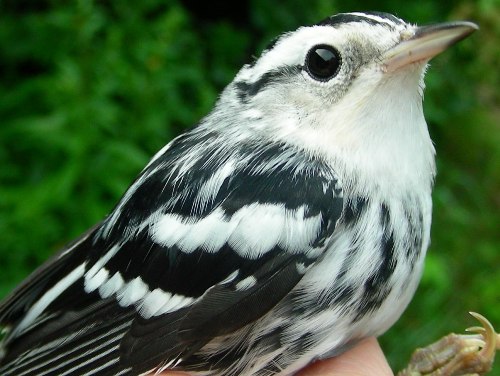
A rather dark AHY female, with some black streaks on the breast contrasting with a
completely white throat.
Photo by Marie-Anne Hudson,
McGill Bird Observatory (QC), August 2008
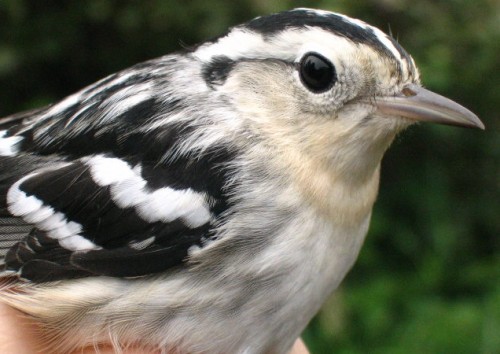
A more typical AHY female, with indistinct streaks on the breast, and a slightly
buffy tone to the throat.
Photo by Seabrooke Leckie,
McGill Bird Observatory (QC), September 2006
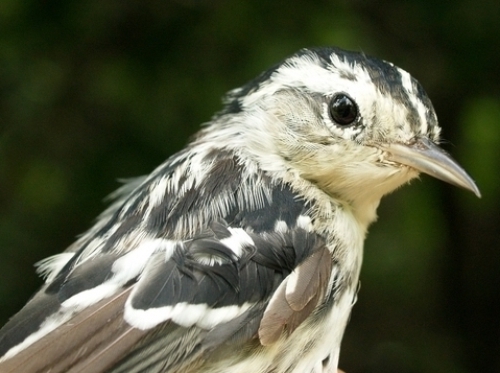
An AHY female undergoing prebasic molt, with the distinctly brown alula and
secondaries recognizable as retained juvenile feathers, making this an SY bird.
Photo by Simon Duval,
McGill Bird Observatory (QC), August 2010
AHY females show a distinct pseudolimit between the blackish greater coverts and the dark gray primary coverts. The primary coverts tend to be distinctly broad and round, which may be helpful in determining age, but often it is useful to also consider the tail and/or skull before reaching a conclusion on age.
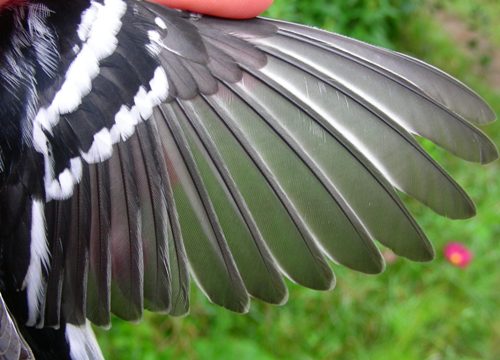
A typical AHY female wing.
Photo by Marie-Anne Hudson,
McGill Bird Observatory (QC), August 2008
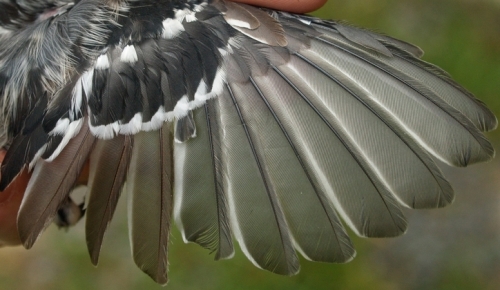
An AHY female during prebasic molt, with the particularly faded brown alula and
secondaries indicating that this is an SY female.
Photo by Simon Duval,
McGill Bird Observatory (QC), August 2010
AHY females have relatively broad and rounded outer rectrices, usually with distinct white patches on the outermost two feathers, but sometimes restricted largely to r6.
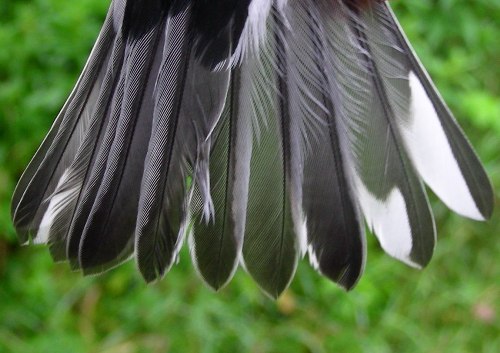
A relatively typical AHY female tail with respect to pattern, though a bit intermediate
in terms of shape.
Photo by Marie-Anne Hudson,
McGill Bird Observatory (QC), August 2008
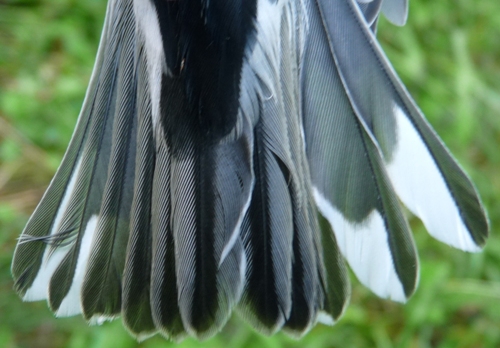
A somewhat more typical AHY tail in terms of rectrix shape.
Photo by Simon Duval,
McGill Bird Observatory (QC), August 2010
RETURN TO AGE/SEX
OVERVIEW
|
JUL - DEC: hatch-year
male |
In terms of overall plumage, HY
males are most similar to AHY females. The auricular and throat are again mostly whitish, though occasionally HY males can be recognized by having a bit of black mottling in the throat. The flanks are whitish with fairly bold, blackish streaking, and lacking the buffy tone present on some females.
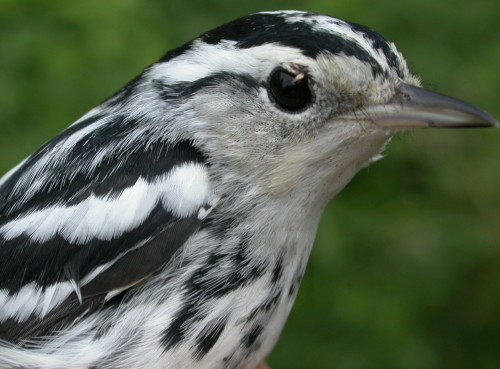
A typical HY male, with a whitish throat and auricular and some dark streaking
on an otherwise white breast.
Photos by Marcel Gahbauer,
McGill Bird Observatory (QC), August 2005
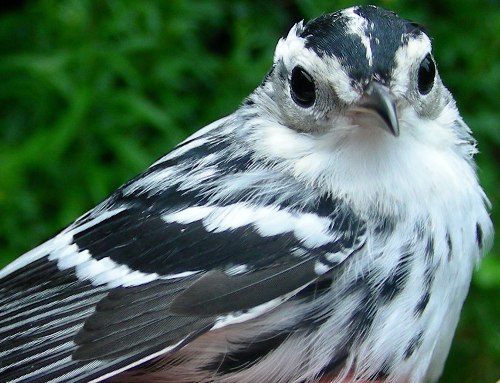
A slightly different perspective on an HY male, with this one also showing the molt
limit on the wing quite nicely.
Photo by Marie-Anne Hudson,
McGill Bird Observatory (QC), August 2008

A comparison between an HY female (left) and an HY male (right), showing the black
to be more pronounced on the male, and some buffy tones present only on the female.
Photo by Seabrooke Leckie, McGill Bird Observatory, September 2006
HY males have a molt limit between the replaced blackish greater coverts and the retained block of duller juvenile primary coverts, primaries, and secondaries. However, this pattern is similar to the pseudolimit on AHY females, and therefore it is usually best to also factor tail and/or skull pneumatization into determination of age.
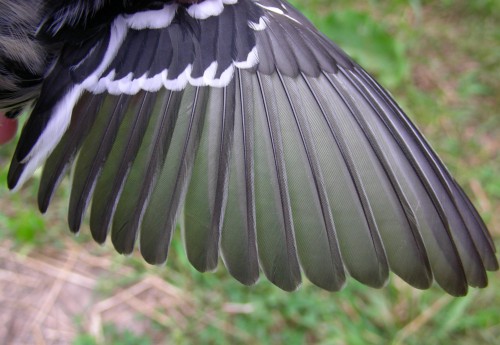
A typical HY male wing, showing the contrast between the replaced formative
greater coverts and the retained duller flight feathers.
Photo by Marcel Gahbauer,
McGill Bird Observatory (QC), August 2007
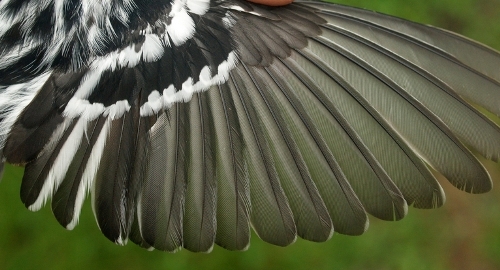
Another example, with the molt limits somewhat more pronounced.
Photo by Simon Duval,
McGill Bird Observatory (QC), August 2010
HY Black-and-white Warblers have outer rectrices that are somewhat narrower and more pointed than those of AHY individuals. HY males tend to have white patches on the outermost two rectrices, but in some cases this may be largely restricted just to r6.
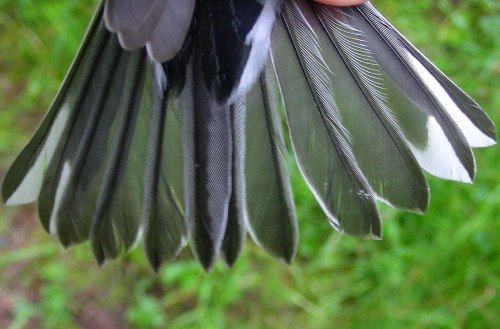
A typical HY male tail, with relatively narrow rectrices and a moderate amount of white
on both r5 and r6.
Photo by Marie-Anne Hudson,
McGill Bird Observatory (QC), August 2008
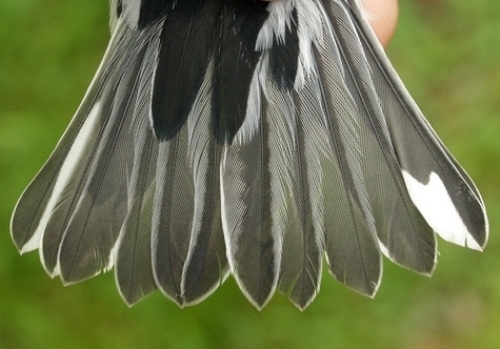
Another example (note that r6 on the right is largely concealed; the pattern is more
evident on the left side). The contrast between the black rump and grayish tail is
often more pronounced on males than females.
Photo by Simon Duval,
McGill Bird Observatory (QC), August 2010
RETURN TO AGE/SEX
OVERVIEW
|
JUL - DEC: hatch-year
female |
HY females are the palest of the Black-and-white Warblers in fall, but can be similar enough to HY males and AHY females that they need to be reviewed carefully. Most have a faint buffy tone to the face and/or flanks, a trait shared by some AHY females.
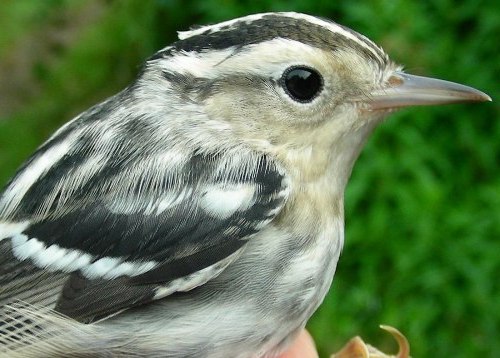
A typical HY female, generally rather dull, with a distinct buff tinge to the face and
upper breast, and with only indistinct streaking on the underparts.
Photo by Marie-Anne
Hudson, McGill Bird Observatory (QC), August 2007
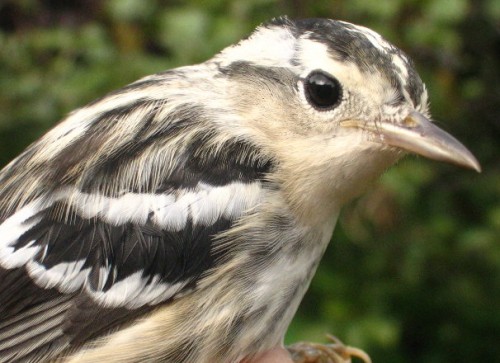
An HY female with buffy markings extending to the flanks.
Photo by Seabrooke Leckie,
McGill Bird Observatory (QC), August 2006
Like HY males, HY females have a molt limit between the replaced formative greater coverts and the retained juvenile block of primary coverts, primaries, and secondaries. Since females are on average somewhat duller overall than males, this molt limit can be particularly difficult to distinguish from the pseudolimit with the same pattern on AHY females, and therefore age of HY females should generally be confirmed by tail and/or skull pneumatization.
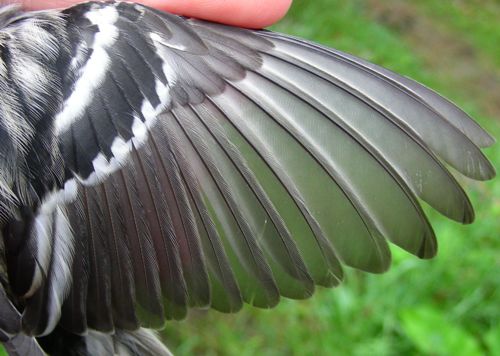
A typical HY female wing, showing the molt limit between the greater coverts and primary
coverts, but note the similarity in appearance with an AHY female wing.
Photo by Marie-Anne Hudson, McGill Bird Observatory (QC), August 2008
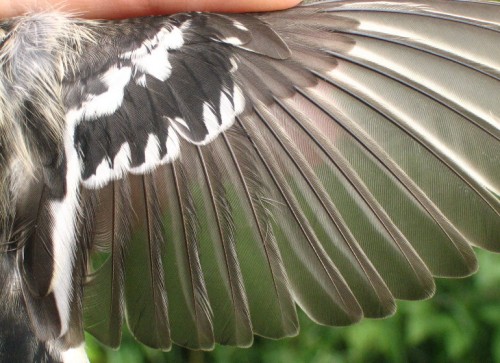
Another example, with the duller nature of the retained juvenile feathers a bit more evident.
Photo by Seabrooke Leckie,
McGill Bird Observatory (QC), August 2006
HY females tend to have the palest tails, with less contrast between the uppertail coverts and rectrices than on males, and also with the amount of white on r5 generally reduced, if present at all. Like HY males, they tend to have relatively narrow and pointed outer rectrices, compared to those of AHY Black-and-white Warblers.
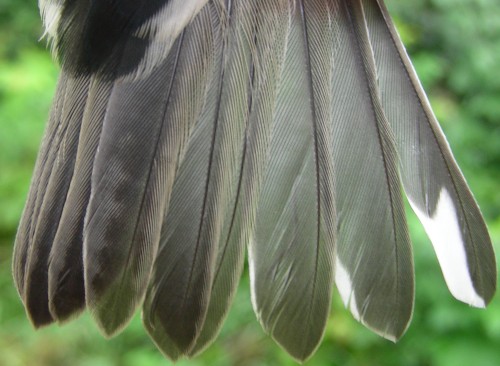
Photo by Marie-Anne
Hudson, McGill Bird Observatory (QC), August 2007
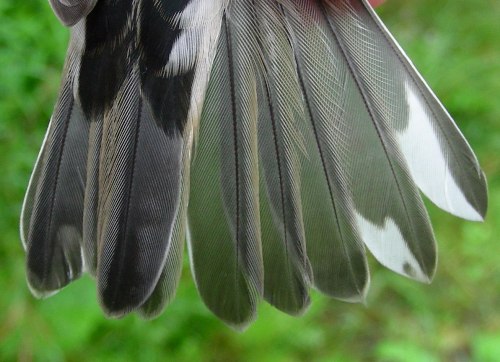
Photo by Marie-Anne Hudson,
McGill Bird Observatory (QC), August 2008
RETURN TO AGE/SEX
OVERVIEW



































































